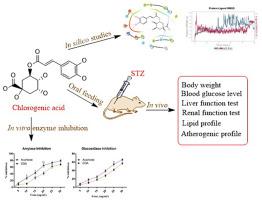Computers in Biology and Medicine ( IF 7.7 ) Pub Date : 2021-05-02 , DOI: 10.1016/j.compbiomed.2021.104462 Amit Kumar Singh 1 , Harvesh Kumar Rana 1 , Vishal Singh 2 , Tara Chand Yadav 3 , Pritish Varadwaj 2 , Abhay Kumar Pandey 1

|
Background
Chlorogenic acid is amongst the well-known polyphenolic compounds being used in human food and beverages. Their presence has been reported in tea leaves, roasted green beans, coffee, cocoa, berry fruits, apples, citrus fruits, and pears.
Objective
The present study aims to elucidate the effectiveness of chlorogenic acid on in silico and in vitro inhibition of glucose metabolising enzymes (α-amylase and α-glucosidase) and on blood-based markers associated with diabetic complications in vivo.
Methods
Docking and molecular dynamics studies were performed using GLIDE (Schrodinger, LLC, NY, 2019-2) and Maestro-Desmond Interoperability Tools, version 4.1 (Schrödinger, NY, 2015), respectively. α-Amylase and α-glucosidase inhibitory activities of chlorogenic acid were measured in vitro. Diabetes was induced in adult Wistar rats by injecting streptozotocin (50mg/kg). Biochemical assays were performed using standard kits.
Result
The in silico studies for α-amylase and α-glucosidase with chlorogenic acid suggested that the ligand was stable and strongly bound with the above-mentioned proteins. During in vitro studies, chlorogenic acid inhibited both the enzymes in a dose-dependent manner (5-30μg/mL). In addition, chlorogenic acid treatment for 28 days significantly suppressed the increase in blood glucose, total cholesterol, triglyceride, glutamic oxaloacetic transaminase, glutamic pyruvic transaminase, γ-glutamyl transferase, alkaline phosphatase, total bilirubin, creatinine, urea, uric acid, and feed intake levels in diabetic rats. Chlorogenic acid also caused significant improvement in body weight, serum HDL-cholesterol, total protein, and albumin levels leading to betterment in atherogenic indices related to diabetes-associated cardiovascular risks.
Conclusion
The findings indicated that chlorogenic acid inhibited α-amylase and α-glucosidase and improved diabetes associated hyperglycemia, hyperlipidemia, and hepatorenal damage, making it a possible functional food ingredient and drug candidate for the management of diabetes and related complications.
中文翻译:

膳食酚类化合物绿原酸在链脲佐菌素诱导的糖尿病大鼠中的抗糖尿病活性评估:分子对接,分子动力学,计算机毒性,体外和体内研究
背景
绿原酸是用于人类食品和饮料的众所周知的多酚化合物。据报道,它们存在于茶叶,烤绿豆,咖啡,可可,浆果,苹果,柑橘类水果和梨中。
客观的
本研究的目的是阐明在绿原酸的效力,在硅片和体外葡萄糖代谢酶(α淀粉酶和α葡糖苷酶)的抑制和与糖尿病并发症相关的基于血液的标记物的体内。
方法
分别使用GLIDE(Schrodinger,LLC,NY,2019-2)和Maestro-Desmond Interoperability Tools版本4.1(Schrödinger,NY,2015)进行了对接和分子动力学研究。体外测定绿原酸的α-淀粉酶和α-葡萄糖苷酶抑制活性。通过注射链脲佐菌素(50mg / kg)在成年Wistar大鼠中诱发糖尿病。使用标准试剂盒进行生化分析。
结果
的在计算机芯片上对α淀粉酶和α葡萄糖苷酶与绿原酸的研究表明,该配体是稳定的,并与上述蛋白强烈地结合。在体外研究表明,绿原酸以剂量依赖的方式(5-30μg/ mL)抑制这两种酶。此外,绿原酸处理28天可显着抑制血糖,总胆固醇,甘油三酸酯,谷氨酸草酰乙酸转氨酶,谷氨酸丙酮酸转氨酶,γ-谷氨酰转移酶,碱性磷酸酶,总胆红素,肌酐,尿素,尿酸和饲料的增加。糖尿病大鼠的摄入量。绿原酸还可以显着改善体重,血清HDL-胆固醇,总蛋白和白蛋白水平,从而改善与糖尿病相关的心血管风险相关的动脉粥样硬化指数。
结论
研究结果表明,绿原酸可以抑制α-淀粉酶和α-葡萄糖苷酶,并改善糖尿病相关的高血糖,高血脂和肝肾损害,使其成为治疗糖尿病和相关并发症的功能性食品成分和候选药物。


























 京公网安备 11010802027423号
京公网安备 11010802027423号